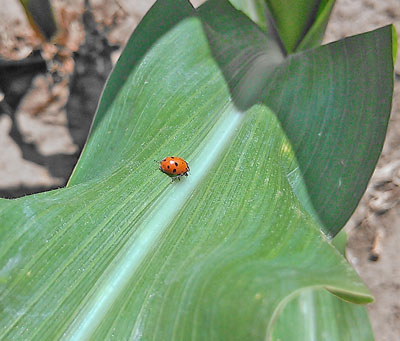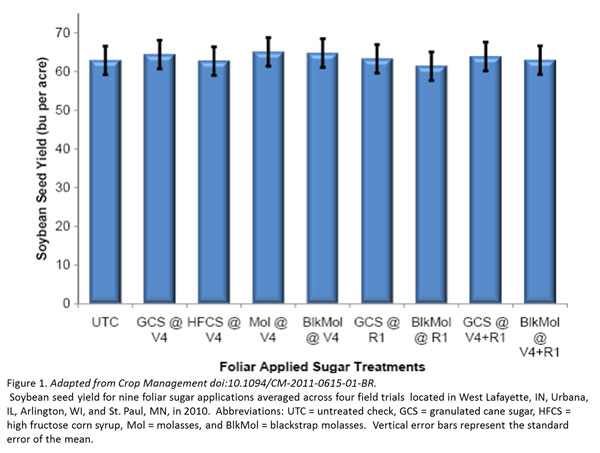Research on Sugar Application to Crops
May 27, 2015

Also view Nebraska research results on applying sugar to crops.
Sugar application to crops has held recent interest for some growers and those in the ag industry. Application of sugar to crops is not new; however, minimal scientific research has been shared in Extension resources regarding this practice. The intent of this article is to highlight some of the research that has been conducted.
Sugar Sources
Many sources of sugar are available in the market for growers to use. These range from granulated beet or cane sugar, brown sugar, high fructose corn syrup, products with other plant-based sugars, and various types of molasses. A study1 was conducted by researchers in Wisconsin, Illinois, Minnesota, and Indiana in 2010 comparing different sources of sugar and an untreated check in soybeans. Their treatments were:
- Untreated Check
- Granulated cane sugar (100% sucrose) applied at V4
- High fructose corn syrup (11 g glucose/fructose per 30 mL) applied at V4
- Molasses (28 g sucrose per 30 mL) applied at V4
- Blackstrap molasses (26 g sucrose per 30 mL) applied at V4
- Granulated cane sugar (100% sucrose) applied at R1
- Blackstrap molasses (26 g sucrose per 30 mL) applied at R1
- Granulated cane sugar (100% sucrose) applied at V4 and R1
- Blackstrap molasses (26 g sucrose per 30 mL) applied at V4 and R1
 All treatments were applied at the equivalent rate of 3 lb sugar/acre and diluted in tap water for a final total spray solution of 15 to 20 gal/acre. The V4 and R1 growth stages were selected to coincide with common glyphosate application times. Research results did not find a statistical yield increase with sugar application [P=0.60] and there were no statistical differences among sugar sources in relation to yield. Results can be seen in Figure 1.
All treatments were applied at the equivalent rate of 3 lb sugar/acre and diluted in tap water for a final total spray solution of 15 to 20 gal/acre. The V4 and R1 growth stages were selected to coincide with common glyphosate application times. Research results did not find a statistical yield increase with sugar application [P=0.60] and there were no statistical differences among sugar sources in relation to yield. Results can be seen in Figure 1.
Another study2 in 2013 looked at sugar application to corn and soybeans. An untreated check was compared to two sugar sources in corn (dextrose and sucrose) which were applied at 4 lb/ac in 20 gallons of solution at V5 corn. In the soybean study, an untreated check was compared to sucrose application at 4 lb/ac at R2 and Headline fungicide at 9 oz/ac applied at R3, both in 20 gallons of solution. The results showed no significant yield differences between the treatments for corn, agreeing with the above-mentioned study with no differences between sugar sources. There was a statistical yield increase for the Headline application in soybeans compared to the sugar application and the untreated check.
Sugar Solution Applications and Beneficial Insects
Numerous studies have shown application of a sugar solution resulted in an increase of beneficial insects. The following are a few selected examples.
Researchers at Utah State University called the application of a sugar-water solution "artificial honeydew" and examined the reaction of beneficial insects to this solution applied to alfalfa. In one study3, plots received one of the following treatments:
- nothing,
- a sugar-water solution,
- a protein supplement in water, or
- the combination of a sugar-protein supplement-water solution.
Adult lacewings and lady beetles always responded positively to the application of the sugar-water solution as did other beneficial insects such as an adult weevil parasitoid, big-eyed bugs, minute pirate bugs, and adult hover flies. There wasn't a consistent positive reaction of beneficial insects to the application of the protein supplement.
Applications of a sugar-water solution were also made in Honduras to corn with beneficial insect counts made immediately and one week after application4. Beneficial insects were 70% higher in sugar-treated plots than in untreated plots immediately after application and twice as high in sugar-treated plots one week after application. Researchers also found an 18% reduction in fall armyworm infestation and a 35% reduction in leaf area damaged by fall armyworm in the sugar-treated plots. They suggested sugar applications to corn allowed for natural enemies to be concentrated and resulted in a reduction of fall armyworm infestation and damage.
USDA-ARS entomologists5 found that lady beetles consuming sugar increased the survival rate of the females and resulted in increased egg production as compared to beetles who were not provided sugar in their diets. They also measured the frequency of feeding and analyzed the gut contents of beetles who fed in soybean plots where sugar was applied versus untreated checks in South Dakota, Maryland, and Kentucky. More lady beetles were found in the sugar-treated plots than in the untreated plots. The researchers suggested sugar-feeding is very important for lady beetle populations and a possible way to help maintain beneficial species in agroecosystems.
In another study6, lady beetles stayed 20-30% longer in plots where sugar-water was applied than in untreated plots. In the first four to six hours after spraying a sugar solution, lady beetles in the sugar-treated plots rose by a factor of 10-20.
Role of Sugar in Plant Defense Signaling
A fascinating recent literature review7 shared the role of sugar in plant mechanisms such as photosynthesis, carbohydrate transport, growth and development, and roles in the plant defense system. It cites a 2007 study8 in rice that evaluated a number of factors including sucrose added to the root system of wild-type rice plants and sucrose sprayed on leaves of rice prior to being inoculated with the fungal pathogen causing rice blast. Sugar application to the root system resulted in over-expression of genes which induce defense mechanisms within the plant. Spraying a sugar solution to plants foliarly and via soil drench resulted in half the disease pressure as that in the control plants one week later. Fifteen days later, control plants exhibited severe disease compared to the sugar-treated plants, suggesting foliar application of sugar prior to an attack by a plant pathogen could signal plant defense responses resulting in increased plant resistance to the pathogen. The researchers noted that all the plants were at the four-leaf stage during this research and were curious if the induced resistance would continue in the plants as they matured.
In conclusion, research has shown no statistical difference among sugar sources when applied to corn or soybeans with no statistical yield increases. Numerous research studies have documented the increase of beneficial insects in fields and plots treated with a sugar-water solution, suggesting application of this solution as a biocontrol method for reducing pest populations. While there is yet much research to be done, sugar does play an important role in inducing plant defense responses and recent studies have shown reduced disease levels in rice after application of sugar prior to pathogen infection.
References
1Furseth, B., Davis, V.M., Casteel, S.N., Naeve, S.L., and Conley, S.P. 2011. Soybean Seed Yield Was Not Influenced by Foliar Applications of Sugar. Plant Management Network doi:10.1094/CM-2011-0615-01-BR.
2Watters, H.D. 2013. Sugar Applications for Corn and Soybean.
3Evans, E.W. and Swallow, J.G. 1993. Numerical Responses of Natural Enemies to Artificial Honeydew in Utah Alfalfa. Environmental Entomology 22(6):1392-1401.
4Canas, L.A. and O'Neil, R.J. 1998. Applications of Sugar Solutions to Maize, and the Impact of Natural Enemies on Fall Armyworm. International Journal of Pest Management 44(2):59-64.
5Durham, S. 2013. Ladybeetle Diet Influences its Effectiveness as Biocontrol Agent. USDA Agricultural Research Service.
6Van der Werf, W., Evans, E.W., and Powell, J. 2000. Measuring and Modelling the Dispersal of Coccinella septempunctata (Coleoptera: Coccinellidae) in Alfalfa Fields. Eur. J. Entomol. 97:487-493.
7Moghaddam, M.R.B. and Van den Ende, W. 2012. Sugars and Plant Innate Immunity. Journal of Experimental Botany.
8Gomez-Ariza, J., Campo, S., Rufat, M., Estopa, M., Messeguer, J., San Segundo, B., and Coca, M. 2007. Sucrose-Mediated Priming of Plant Defense Responses and Broad-Spectrum Disease Resistance by Overexpression of the Maize Pathogenesis-Related PRms Protein in Rice Plants. Molecular Plant-Microbe Interactions 20(7):832-842.
Acknowledgment
Special thanks to Bob Wright, Nebraska Extension Entomologist, for providing some of the entomology manuscripts for the author.
Jenny Rees
Nebraska Extension Educator
Online Master of Science in Agronomy
With a focus on industry applications and research, the online program is designed with maximum flexibility for today's working professionals.
